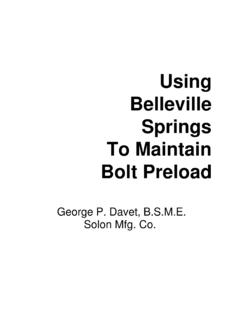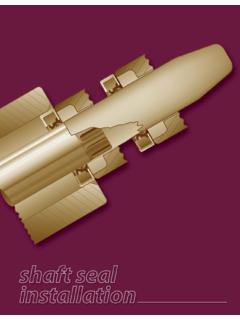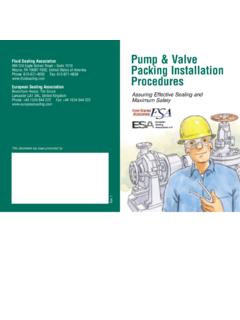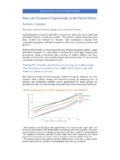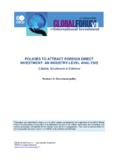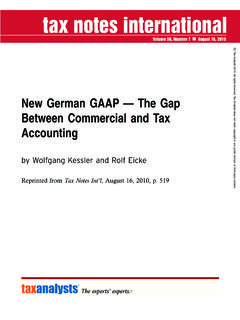Transcription of Bearing Protection Devices and Equipment …
1 20 OCTOBER & SYSTEMSR otating labyrinth seals (commonlycalled Bearing protectors and bearingisolators ) can be found in many OEMand retrofit applications. Bearing isola-tors are an improvement over the olderstationary labyrinths. They come in differ-ent versions, however, and some may notperform as expected. Pressure-relief poppet valves aremarketed for the Bearing housings ofcentrifugal pumps and other can be shown that they are rarely, if ever,of any merit. Finally, a new generation of on-linemoisture-monitoring Devices and desic-cant-containing absorber cans are offeredby competent manufacturers. They areintended for mounting at the top of thevapor space of pump Bearing housingsbut are not always cost-justified. Rotating-Labyrinth Bearing -HousingSealsIt has long been recognized that as manyas 91% of all the rolling element bearingsinstalled in the world s machinery fall shortof reaching the manufacturer s calculatedL-10 life.
2 L-10 is defined as the numberof operating hours at which 10% of anidentical Bearing population will eitherhave failed, or will exhibit visible ormeasurable damage. Simple subtractionreveals that 90% of bearings shouldbeexpected to surviveto L-10 life. Researchand follow-up analysis have establishedlubricant contamination as the predomi-nant cause of failure. Much airborne contamination finds itsway into Bearing housings throughopenings where shafts protrude throughbearing housings, or at vents and breatherson the lubricated assembly. Bearinghousings undergo temperature shiftsbetween day and night, and in operat-ing/idle cycles. With increasing temper-atures, the vapors above the liquid oil willexpand and, with decreasing tempera-tures, they will contract. In a closedvolume, increasing temperatures causepressures to go up, while decreasingtemperatures cause pressures to decrease.
3 In an effort to reduce the pressure-related, in-and-out flow of contaminatedair, conventional labyrinths are oftenreplaced by rotating-labyrinth seals (whichwe will describe as protector/isolators, forshort. A typical version is shown in Fig. 3). These Devices are designed withinherent clearances, so an air gap separatesthe rotating and stationary when the clearance is bridged byan oil film, this gap is large enough to allowthe exchange of air with its ever-presentcontaminants, water vapor and has been pointed out that bearingprotector/isolators work best when thehousing vent is plugged. To quote oneprominent manufacturer ( ): If the housing vent is left open, theslight vacuum created by the contam-inant expulsion elements will inducethe flow of airborne dust, dirt, vaporsand everything available in theimmediate environment through thebearing enclosure not unlike an oil-bath vacuum cleaner.
4 This action isconstant and the amount of induceddebris build-up can be significant. Bearing Protection Devices and Equipment Reliability:Part II What is Really Justified?An ounce ofprevention isworth a poundof P. Bloch, ,Consulting Engineer,Process MachineryConsultingBearing isolators fitted with dynamic O-rings (Fig. 4) try to close the gap throughwhich airborne contaminants can enter thebearing housing. The expectation is for theO-ring to effectively seal off the gap at stand-still (Ref. 2). The designer/manufacturerhopes that centrifugal force, acting on therotating O-ring during operation, will causethe ring to lift off sufficiently to avoid thescraping and galling wear modes noted oncircumferentially contacting dynamic O-rings (such modes are why O-ring manufac-turers do not recommend high-cycle,dynamic, circumferential sealing applica-tions). Bearing protector/isolators equippedwith dynamic vapor blocking O-rings arelikely to outperform isolators that do notincorporate a dynamic O-ring, in that theydo prevent air intrusion on production of these componentsexceeds 175,000 per year ( ).
5 Many practicing engineers, however,have voiced concerns with mistaken claimsthat these Devices provide hermetic sealing. Reliability professionals correctlyreason that if the O-ring does lift off, therestill will be a gap through which contam-inated air moves. Conversely, if there is nogap, there will be wear. Thus, contrary towritten claims dating back about a decade,even Bearing protector/isolators designedwith dynamic O-rings will not achievehermetic sealing during Sealing is the PreferredSolutionHermetically sealing the bearinghousing implies that nothingenters andnothing escapes. Only face-to-face sealingdevices meet this definition. In view of thegenerally limited axial space betweenbearing housings and fluid casings ofcentrifugal pumps and other machinery,narrow-width, magnetically closing faceseals have been developed in there exists a thinfilm of clean oil between eitherspring-activated or magnet-activated seal faces, long seal lifeand hermetic containment of thelubricating fluids result.
6 Tens ofthousands of the magnetic faceseals shown in Fig. 5 have beenused in aircraft task pumps, asaircraft generator seals, and onvertical stabilizer units ( ).They can tolerate rubbing veloc-ities as high as 86 m/s (17,000fpm) and temperatures to 200 C(392 F), and have frequentlyserved to everyone s satisfactionfor over 50,000 operating seals have performedequally well in such industrialapplications as gun drills,gearboxes and pump use a single Al-Ni-Comagnet annulus to attract theopposing seal rather similar seal (Fig. 6)incorporates a series of strongrare-earth magnetic rods to To this day, some important lubricant-application and Bearing - Protection issues are overlookedor misunderstood in the typical process-plant environment. In Part I of this series concerning thoseissues, the author compared the types of available constant-level lubricators, and found thepressure-equalized (PEL) designs superior to those that were open-to-atmosphere (OTA).
7 Inthis conclusion, the noted lubrication expert reviews various contamination-prevention and pressure-relief alternatives, with focus on cost and reliability-based : Rotating labyrinth seal ( Bearing protector/isolator)(Source: Inpro/Seal Company, Milan, Illinois; ) : Bearing protector/isolator with dynamic O-ring (Source: Inpro/Seal Company, Milan, Illinois; )PUMPS & 200121attract the opposing face. Superior face-material combinations achieve coefficientsof friction that, even without lubricationpresent, rival those of PTFE. The station-ary seal face of the product in Fig. 6 (alsoshown in insert, Fig. 8) has a diamond-likehardness (RC90, ). Thousands ofmachines in different industries have beenfitted with this particular type of seal, andyearly production exceeds 60,000 (withprimary applications in centrifugal pumpsin hydrocarbon processing and relatedindustries).
8 Figure 7 shows a magnetic seal whosecontacting faces are pushedtogether by therepelling action of rod magnets of like polar-ity. Although repulsion magnetic sealsembody certain advantages over the pullingconfigurations they are more expensive tomake and take up more axial space. Veryfew of these seals have been sold since theirintroduction in 1992, and only a few dozenwere produced in 2000. Magnetic seals obtain lubri-cation and cooling from the ever-present oil fog that surroundsoil-lubricated bearings. Properlydesigned, using appropriate facematerials and applying suitableselection criteria, they representthe ideal choice of Bearing -housing seal to prevent bothegress of lube oil and ingress ofatmospheric the temperature-dependent pressure inside anon-vented Bearing housing riseabove the magnetic closing force,the seal would release pressureby opening and immediately seals of the typeshown in Figs.
9 5 and 6 willperform flawlessly, either withpressure-balanced constant-level lubricators or non-ventedbearing housings, and they areideal for closed, environmen-tally acceptable oil-mist lubri-cation systems. In a closed,oil-mist application, the oil mistis introduced in the spacebetween magnetic seal andbearing ( ). Excess liquid orvaporized oil is led off or collected at thebottom-center location of the bearinghousing (Fig. 8, and ).Pressure-Relief Poppet Valvesare Rarely NeededPressure-relief poppets, similar to the oneshown in , have been offered as retro-fit items for Bearing housings of centrifu-gal pumps and other machinery. The weightof the ball exerts a downward force on theseat. Whenever the product of pressureinside the Bearing housing multiplied bythe exposed area (= upward force) exceedsthe downward force on the seat, the ball willunseat itself and will allow excess internalpressure to escape to atmosphere.
10 A steel ball of 3/8 inch ( mm) diame-ter weighs lb ( gm). Assumingan exposed area of sq. in., it would takea pressure increase of psi [or in. (40 mm) of H2O column] overatmospheric to unseat the steel ball (althoughPVC balls would relieve at lower pressures). If Equipment is fitted with labyrinth sealsor Bearing protector/isolators (either with orwithout O-rings), slightly negativepressuresmay actually exist inside the Bearing housingdue to pumping action brought on by thecontaminant expulsion elements (Ref. 1). Bearing protector/isolators with designs thatavoid such pumping action have a liberalseparation between rotating and stationaryelements, and will provide pressure equal-ization between housing interior and thesurrounding, external atmosphere. Consis-tent pressure build-up can occur only in trulyhermetically sealed Bearing housings,( ,with magnetic seals).
